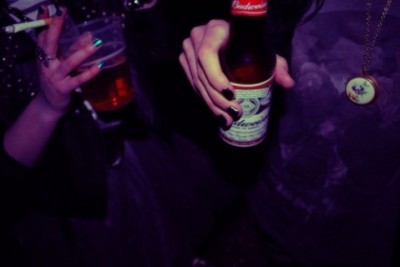The stockings were hung by the chimney with care…
…and Dad passed out beers without so much as a care?
With holiday festivities well under way, many partygoers will be drinking and toasting the season—teens included. And believe it or not, many of those teens will get the liquor from Mom and Dad. According to a recent poll administered by Drinkaware in the U.K., nearly half of parents surveyed felt comfortable giving their teens (ages 14 to 17) alcoholic beverages to take to a party—even though it is illegal.[1] And three in five parents said they would allow their teens to take alcohol with them on holiday.1
How does that translate in the U.S.? Well, in 2013, 11.6 percent of adolescents between 12 and 17 admitted to being current alcohol users. That equates to 2.9 million teenagers.[2] And many of those teens’ parents are their suppliers. Parents often believe the myth that they are decreasing their child’s risk for continued drinking later in life by providing the alcohol at home—in a safe environment. But the opposite is true. Studies prove that supplying alcohol to minors increases the chances of drinking later in life and actually attributes to problem drinking as they age.[3] According to Steve Pasierb, president and CEO of the Partnership for Drug-Free Kids:
“Childhood drinking is foremost a health issue. Many well-intentioned parents think that supplying alcohol for their child to drink at home may teach them how to ‘drink responsibly’ and might prevent them from drinking elsewhere. But the truth is that early consumption of alcohol in any context increases the likelihood of harmful effects in the long run. What’s more, studies have shown that when parents supply alcohol to their kids, it actually increases the risk for continued consumption during childhood and lifetime
problem drinking. Drinking in the home does not prevent children from drinking outside the home or with their friends.”3
Pouring your kid a beer at the dinner table doesn’t demystify alcohol. It encourages its consumption. Nearly 11 percent of all alcohol consumed in the U.S. is by underage ’tweens and teens. And what’s even more concerning? Fifty-six percent of those underage drinkers (ages 12 to 20) reported that their last use of alcohol occurred in someone else’s home; thirty percent reported that it occurred in their own home; and 21 percent were given it by a parent, guardian, or other adult family member.[4]
Parents, it’s time for a reality check. Regardless of your stance on alcohol consumption, the best thing parents can do is set up strict boundaries in this area—and be especially aware of their teen’s comings and goings during the holiday season. Have an open conversation about drinking, because your child has most likely already faced the temptation to drink.
Proverbs 22:6 says, “Train up a child in the way he should go, and when he is old he will not depart from it.” It is a parent’s responsibility to harness a child’s most vulnerable years and direct their paths. Educating them, teaching them, is key to a future free from alcohol addiction.
Lastly, your teen probably spends more time focusing on how to fit in than they do about the consequences of their actions, so you may want to lovingly let them in on a few, hard-hitting statistics:
- Nearly 5,000 young people under the age of 21 die each year from underage drinking. (Article published in 2007).[5]
- According to Mothers Against Drunk Driving (MADD), the most dangerous driving days are between Thanksgiving and New Years Day. Because alcohol consumption spikes.
- MADD reports that while overall drunk driving incidents have decreased, there has been an increase in the proportion of drunk-driving deaths around the holidays.[6]
- In 2012 alone, 830 people lost their lives during the month of December due to drunk driving.[7] That same year, 239 children under the age of 15 were lost to drunk driving, accounting for 20 percent of all accidents involving a child.[8]
- Statistics have shown that 21 percent of murders committed by young people are caused by alcohol. (Article published in 2007.)5
- Estimates suggest that each year: one million nonfatal injuries are caused by underage drunk drivers, one million assaults by youth are committed under the influence of alcohol; and there are 40,000 cases of alcohol poisoning. (Article published in 2007).5
Permission to drink at home translates to permission to do it elsewhere. Draw a clear line in the sand, a strong boundary. There is, perhaps, no greater long-term gift you can give your child this holiday season, when alcohol consumption spikes, than speaking the truth in love. Doing so could prevent years of heartache and regret. It could even save a life.
[1] Chan, Emily. “Giving Teens Alcohol at Christmas Parties: Reckless or Realistic?” The Telegraph. Telegraph Media Group, 21 Jan. 2004. Web. 12 Dec. 2014. <http://www.telegraph.co.uk/foodanddrink/11272810/Giving-teens-alcohol-at-Christmas-parties-reckless-or-realistic.html>.
[2] Substance Abuse and Mental Health Services Administration, Center for Behavioral Health Statistics and Quality. (September 4, 2014). The NSDUH Report: Substance Use and Mental Health Estimates from the 2013 National Survey on Drug Use and Health: Overview of Findings. Rockville, MD.
[3] Dawson, et al., 2008; Grant and Dawson, 1997; Hingson et al., 2006; Winters and Lee, 2008
[4] Gregston, Mark. “Teaching Teens to Avoid Alcohol.” Crosswalk.com. Crosswalk, 3 Mar. 2012. Web. 12 Dec. 2014. <http://www.crosswalk.com/family/parenting/teens/teaching-teens-to-avoid-alcohol.html>.
[5] Arterburn, Stephen, and Jim Burns. “Alcohol and Your Teen.” Crosswalk.com. Crosswalk, 6 June 2007. Web. 12 Dec. 2014. <http%3A%2F%2Fwww.crosswalk.com%2Ffamily%2Fparenting%2Falcohol-and-your-teen-11545214.html>.
[6] “MADD’s “Tie One On For Safety” Holiday Campaign Cautions Drivers as More Highway Deaths Caused by Drunk Driving.” MADD. Mothers Against Drunk Driving, 13 Nov. 2012. Web. 12 Dec. 2014. <http://www.madd.org/media-center/press-releases/2012/MADDs-tie-one-on.html>.
[7] “GET INVOLVED.” MADD. N.p., n.d. Web. 12 Dec. 2014. <http://www.madd.org/blog/2014/december/national-impaired-driving.html>.
[8] NHTSA data query, 2013.
 The Bottom Line, Ministries Christian News, Articles, & Poetry
The Bottom Line, Ministries Christian News, Articles, & Poetry 





Samantha,
These are some very startling statistics. I think a lot of times people get too wrapped up in trying to have fun and it translates into irresponsibility. Unfortunately, this results in serious impairment, or even death for some. Hopefully this article will bring some awareness. You just never know; it might even save some lives. Thank you so much for sharing this. God bless.
I think people tend to ignore statistics. In spite of the fact that they are quite clear about dangers.
Adults and teens alike need to realize that the ‘harmless’ fun at a party or the ‘social’ drinking that occurs may indeed be ‘harmless’ this time, but it opens a door. One cannot know if we are the one that will fall victim to alcoholism unless we consume alcohol. We think in the moment rather than about the potential for tragedy and bondage. Most people believe ‘Oh that would never happen to me.’ We underestimate satan’s deception and overestimate our own control.